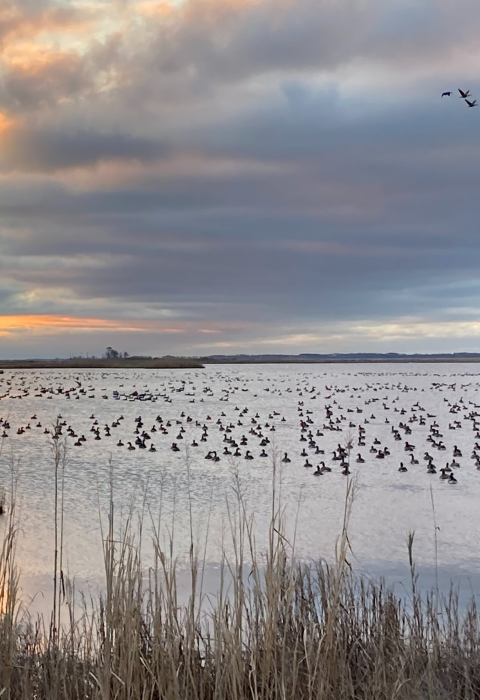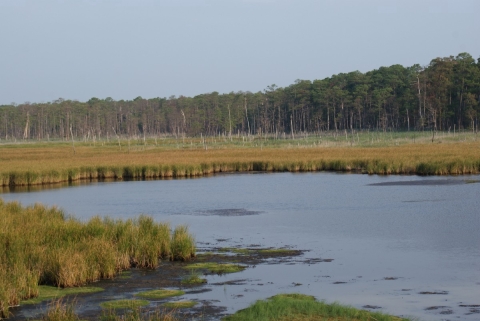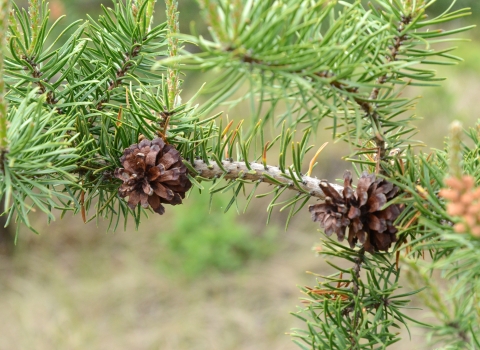A lot has changed since 1973. On the 50th anniversary of the Endangered Species Act, land managers, biologists and bird-lovers alike are studying how a changing climate has affected bird populations and reflecting on what the next 50 years may look like for the species we love, endangered or otherwise.
As climate change climate change
Climate change includes both global warming driven by human-induced emissions of greenhouse gases and the resulting large-scale shifts in weather patterns. Though there have been previous periods of climatic change, since the mid-20th century humans have had an unprecedented impact on Earth's climate system and caused change on a global scale.
Learn more about climate change causes global average temperatures and sea levels to rise, conservationists are finding tools that will best prepare them to protect the species we love and the lands they depend on. From predictive models that point us in the right direction to revised management guidelines, the Service is preparing for the climate of the future.
Hundreds of birds, hundreds of refuges
In 2022, U.S. Fish and Wildlife Service and National Audubon Society researchers published a study that predicts how the shift in global temperature averages will affect bird populations across 525 national wildlife refuges.
The research shows that, with a 2° Celsius warming scenario, half the birds in the national wildlife refuge national wildlife refuge
A national wildlife refuge is typically a contiguous area of land and water managed by the U.S. Fish and Wildlife Service for the conservation and, where appropriate, restoration of fish, wildlife and plant resources and their habitats for the benefit of present and future generations of Americans.
Learn more about national wildlife refuge system will see a change in the fit of their habitat— with climate change, the landscape and weather patterns may shift to no longer fit their needs. This means that by 2050, on average, about a quarter of the bird species you see on any refuge could be different from what they are now.
As refuge ecosystems warm, birds that would otherwise migrate south may overwinter in place or settle farther north than their historical range. In the summer, birds may fly to refuges farther north, to reach cooler temperatures. The researchers predict more turnover in species at refuges in the north than at those farther south.
Researchers used scientific modeling to predict changes in vegetation and bird species distribution in relation to climate change. Pat Heglund, retired regional refuge biologist in the Midwest who worked on the study, explained – this is what determines the authors’ assessment of habitat fit.
Heglund noted that temperature stress due to climate change can affect species both directly and indirectly, which includes shifting vegetation.
Sea-level rise over temperature increase
While it’s likely to alter species’ ranges, average temperature change isn’t the biggest climate concern for birds on the northeastern U.S. coast; sea-level rise is.
The Audubon researchers added a disclaimer where sea-level rise — not temperature difference — will have a larger impact on bird populations. They identified this as an area for future research.
“I mean the 800-pound gorilla in the room is sea-level rise for these birds, and we are focused pretty much entirely on that,” said Dave Curson, director of bird conservation for Audubon Mid-Atlantic, who was not associated with the recent study but works closely with the Service on managing marsh habitats in response to climate change.
“If we're talking about these marsh birds, it's pretty much all about the flooding regime and sea-level rise,” Curson said. “Increases in temperature may have a little bit of effect, but I would be guessing about what those [effects] might be.”
When it comes to sea-level rise, biologists know what those effects might be.
Birds of Lake Blackwater
The Mid-Atlantic, where Blackwater National Wildlife Refuge sits, offers a hyper-vivid example of a trend happening all along the East Coast’s salt marshes.
On the refuge, rising waters have submerged more than half the original wetland habitat; the Blackwater River has converted so much marsh to open water, that the area is now called “Lake Blackwater.”
“It does shift things,” when it comes to bird population distribution, said Matt Whitbeck, supervisory wildlife biologist at the Chesapeake National Wildlife Refuge Complex, which includes Blackwater. “We now have a large body of water in the middle of the refuge that wasn't there before, so species like common merganser have become much more abundant on the refuge in the winter. White pelicans are staying the winter — birds that use deeper, fresh-to-very slightly brackish conditions are starting to overwinter on the refuge. We are seeing some species show up and utilize that big body of open water that we have now.”
The issue is that these birds are not necessarily a “high conservation concern,” as Whitbeck put it. The ones that are — saltmarsh sparrow, black rail, and similar birds that need salt marshes — are losing their habitat.
Rising sea levels and more-intense storm surge are converging with human alterations that make it harder for marshes to drain. In Chesapeake Bay, the marshes have a particularly low tidal range, which means they’re flat. When a higher tide comes in, it “isn’t going to nibble away at the shoreline; it’s going to submerge the entire marsh platform,” as Curson described.
The daily tidal regime is leaving marshes waterlogged and eroded.
Curson called this problem “existential” for many of the birds that call salt marshes home. These birds, in particular, have less flexibility to migrate farther north or deeper inland because their habitat needs are so specific.
“They’re all squeezed into just this tiny little ribbon of habitat along the coast,” he said.
Climate lessons beyond birds
It may feel inconsequential if a small and already-declining species slips away altogether as sea levels rise. And, perhaps it is even less concerning if a beloved species doesn’t disappear but simply moves farther north as temperatures increase.
However, paying attention to how birds react to sea-level rise and temperature change yields insights beyond the individual species: “Birds are indicators of other species that are harder to sample,” Joanna Wu, one of the lead authors of the study, explained.
By noticing how birds respond to changes in climate and sea level, humans can better understand how we, other species, and the ecosystems we live in and rely on might be affected by those same changes.
For wildlife managers like Whitbeck and Curson, who make choices about how to direct changes on the landscape, that information is powerful.
“As climate changes beyond historical ranges of variability, refuge managers are confronted with assessing the utility of refuges, including how to best manage refuges both individually and as a system to help species cope with rapid change,” the study authors write.
“[The models] aren’t designed to make definitive predictions, but they are designed to stimulate our thinking and inform our decision-making,” Heglund said. “Our climate-based projections, when combined with other projections like those regarding sea-level rise, can help managers develop alternative management scenarios and consider appropriate management actions in response.”
The study authors not only ask, but also begin to answer, how land managers can adapt and manage for these changes. They highlight the Resist-Accept-Direct, or RAD, framework, a relatively new way of thinking that guides the choices managers make when planning for climate change.
The framework outlines three options:
- Managers can resist change, as the Service has done traditionally, by aiming to restore or maintain habitats and species populations to some baseline of what it’s been in the past. (Though, as many point out, this is often an arbitrary baseline, set well after humans were affecting the landscape.)
- They might accept the change, allowing the powerful forces of climate change to forge ahead and reshape the land.
- Or they can direct the change by acknowledging that there are elements of climate change humans cannot resist (like sea- level rise) and working within those confines to still create habitat for priority species.
“Ten-to-fifteen years ago, the model was just to resist change,” said Wu. “The thing that excites me most working with Fish and Wildlife [Service] managers is that we can put [these results] into a RAD framework.”
“[RAD] shifted the way that I think about managing these coastal landscapes,” Whitbeck said of the plan in an interview last year. “The gold-standard for managing these habitats was precolonial conditions: What did this look like historically before Europeans arrived and started altering these systems so radically? That’s kind of always been the benchmark for how we managed these systems, but being here at Blackwater drove home the point that, at least in some instances, that really may not be the best idea anymore.”
At a place like Blackwater, where sea-level rise is consuming the landscape, resisting the change is not an option. But all is not lost, either. As existing landscapes are shifting into new ones, the refuge can still meet its conservation goals.
RAD changes
In the short-term, we’re working with partners — Audubon Mid-Atlantic and the Conservation Fund — to help the marshes keep up with sea-level rise. One way of doing this is adding thin layers of sediment to the top of the marsh, so the surface can literally rise as the coastline does. This is a classic example of resisting. Partners in the Chesapeake are also working to help excess water drain off the surface of the marsh more quickly — to prevent erosion and waterlogging. They do that by digging little channels, called runnels, on the marsh surface, so water can flow back into a waterway.
Blackwater 2100, a collaborative plan between the Service, Audubon Mid-Atlantic and the Conservation Fund, lays out a strong vision for directing marsh change and incoming tides. It identifies areas for protection, where managers can facilitate migration of the marsh farther inland over the next century. As tide moves further inland, so too can marsh.
“If we look at Lake Blackwater, the forces of sea-level rise and subsidence are so great out there, that trying to force [the land] back to historical conditions may not be the most productive strategy. Thinking about where habitats may be created because of these same changes may be a better way to think about managing these systems,” Whitbeck said. “We still want to provide this habitat for fish, wildlife and plant resources; we still want to provide these ecosystem services; but they don’t necessarily have to be in the same square foot.”
Directing action based on the observed changes due to climate is exactly the outcome that Wu had hoped the study would provoke. A lover of refuge lands and conservation spaces, she knows these protected places are not the end-all-be-all of climate work.
“I hope [readers] see that just setting aside land is not enough,” she said. “Even those really well-managed, really well-protected areas can’t escape climate change.”






